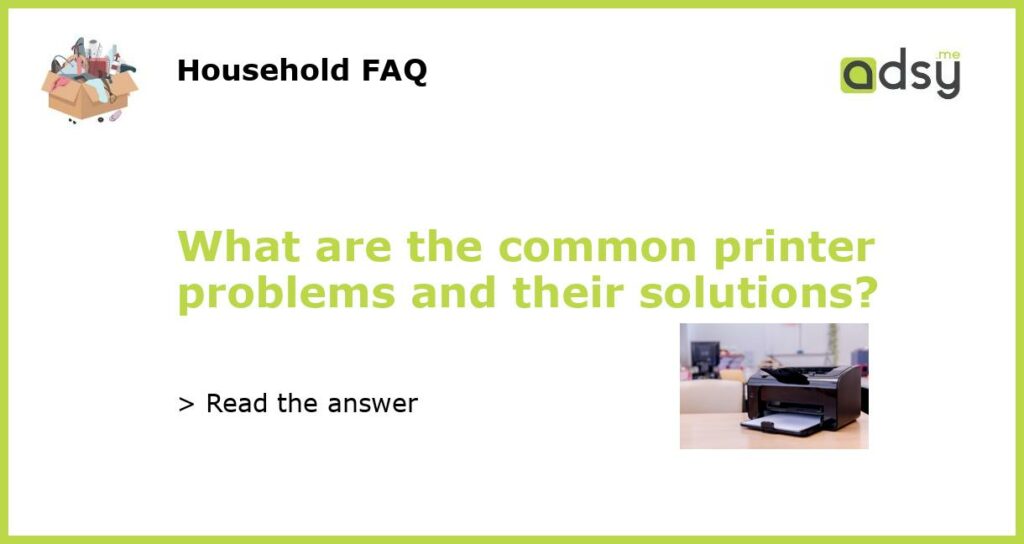Common Printer Problems and Their Solutions
Printers have become an integral part of our professional and personal lives, helping us transform digital images and documents into physical copies. However, just like any other technological device, printers can face various issues that can sometimes be frustrating to deal with. In this article, we will discuss some common printer problems and their solutions, helping you troubleshoot and resolve these issues quickly.
Printer not Printing
One of the most common issues users face is when their printer fails to print. This can be caused by a variety of factors, including a connectivity problem, incorrect printer driver installation, or a paper jam.
To resolve this issue, start by checking the printer’s connectivity. Make sure the USB cable or wireless connection is secure and properly connected between the printer and the computer. If the connectivity is fine, check if the printer driver is correctly installed. You can do this by going to the Control Panel or Settings on your computer, navigating to the Devices and Printers section, and selecting your printer. If you see a yellow triangle or exclamation mark next to the printer icon, it indicates a problem with the driver. In this case, try reinstalling the printer driver.
If both connectivity and the printer driver are not the issue, then it is worth checking for a paper jam. Open the printer cover and look for any stuck or crumpled papers. If you find any, carefully remove them and then try printing again.
Slow Printing Speed
Another common printer problem is slow printing speed. This can be frustrating, especially when you have a large number of documents or images to print.
The slow printing speed can often be caused by the print quality settings being set too high. To resolve this issue, go to the printer settings on your computer and adjust the print quality to a lower setting. This may slightly reduce the print quality, but it should significantly increase the printing speed.
Another potential solution is to check if the printer’s firmware is up to date. Sometimes, outdated firmware can lead to slower printing speeds. Visit the manufacturer’s website and download the latest firmware for your printer model. Follow the instructions provided to update the printer’s firmware and check if it improves the printing speed.
Printer Producing Faded or Smudged Prints
Faded or smudged prints can be a frustrating issue, as they can make documents or images difficult to read or see clearly. This problem is often caused by an issue with the printer’s ink cartridges.
To resolve this issue, start by checking the ink levels of the cartridges. Most printers have an ink level indicator that can be accessed through the printer settings on your computer. If the ink levels are low, replace the cartridges with new ones.
Another common cause of faded or smudged prints is clogged print heads. Print heads can become clogged over time due to dried ink or debris. To clean the print heads, access the printer maintenance settings through the printer settings on your computer. There should be an option to clean the print heads. Follow the on-screen instructions to clean the print heads, and then try printing again.
Printer Displaying Error Messages
When using a printer, it is common to encounter error messages on the device’s display. These error messages can vary, such as “Paper Jam,” “Ink Cartridge Error,” or “Printhead Problem.”
To resolve error messages, start by turning off the printer and unplugging it from the power source. Wait for a few minutes, and then plug it back in and turn it on. Sometimes, a simple power cycle can resolve the issue.
If the error message persists, consult the printer’s user manual or visit the manufacturer’s website for instructions on how to troubleshoot specific error messages. Many manufacturers provide step-by-step guides to resolve common error messages.
Wi-Fi Connectivity Issues
Wi-Fi connectivity issues can be a common problem, especially when trying to connect a wireless printer to a network. These connectivity issues can prevent your printer from receiving print jobs.
To resolve Wi-Fi connectivity issues, start by restarting your printer and the Wi-Fi router. Sometimes, a simple restart can resolve the problem.
If the issue persists, check if your printer and Wi-Fi router are using the same network frequency (2.4GHz or 5GHz). If they are on different frequencies, try connecting them to the same frequency.
Additionally, ensure that your printer is within range of the Wi-Fi router and that there are no physical obstructions blocking the Wi-Fi signal. If the signal strength is weak, consider moving the printer closer to the Wi-Fi router or using a Wi-Fi range extender to boost the signal.
By understanding and troubleshooting these common printer problems, you can keep your printer running smoothly and efficiently. However, if you encounter persistent issues or are unsure about how to resolve them, it is always beneficial to consult the printer’s user manual or contact the manufacturer’s support team for further assistance.






